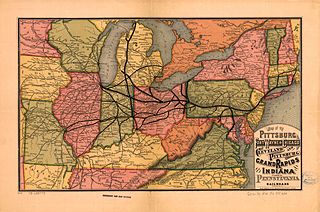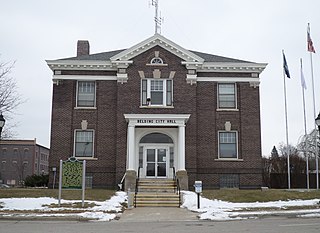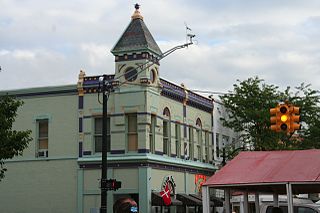
The Chicago, Kalamazoo and Saginaw Railway (CK&S), known informally as the "Cuss, Kick & Swear" is a defunct railroad which operated in southwest Michigan in the late 19th and early to mid 20th centuries. Despite the name, the line ran entirely within the state of Michigan, with the majority in Kalamazoo County. It eventually became part of the New York Central. As of 2010, most of the former CK&S tracks have since been abandoned.
The Saginaw and Mount Pleasant Railroad was a wholly owned subsidiary of the Flint and Pere Marquette Railroad (F&PM). It was established to construct a 14.7-mile (23.7 km) railway line from a junction with the F&PM main line at Coleman, Michigan, to Mount Pleasant, Michigan. The line opened on December 15, 1879, as a 3 ft narrow gauge line. In mid-1884 the line was converted to 4 ft 8 1⁄2 instandard gauge. On January 31, 1889 the company was formally merged into the F&PM along with the East Saginaw and St. Clair Railroad, the Saginaw and Clare County Railroad, and the Manistee Railroad.
The Flint River Railroad is a defunct railroad. It was established on December 6, 1871 to construct a 14.4-mile (23.2 km) branch from Horton to Otter Lake to support the logging industry in the Flint River area. This line was opened on October 8, 1872, and the company was consolidated with the Flint and Pere Marquette Railroad (F&PM). In 1881 the F&PM extended this line 5.2 miles (8.4 km) to Fostoria.
The Detroit, Lansing and Northern Railroad (DL&N) is a defunct railroad which was formed on December 27, 1876 as a reorganization of the foreclosed Detroit, Lansing and Lake Michigan Rail Road. The segment of its main line from Detroit to Lansing became an important component of the Pere Marquette Railroad, organized in 1900, and is still in use by CSX.
The Grand Rapids, Kalkaska and Southeastern Railroad is a defunct railroad which operated in Northern Michigan toward the end of the 19th century. The company was founded on August 30, 1897 by William Alden Smith, a Republican politician and former general counsel of both the Chicago and West Michigan Railway and the Detroit, Lansing and Northern Railroad. The GRK&S constructed a 40.73-mile (65.55 km) line from northern Missaukee County through Kalkaska to Rapid City, where it met the C&WM's main line. The C&WM undertook to supply rolling stock and oversee construction in exchange for a 10-year lease of the line.
The Ionia and Lansing Rail Road is a defunct railroad which operated in the state of Michigan in the 1860s and 1870s. The company incorporated on November 13, 1865; the investors hailed primarily from Lansing, Ionia and Portland. The original charter called for a 34-mile (55 km) from Ionia to Lansing; on January 13, 1869 this was amended with a much grander vision: a 125-mile (201 km) line from Lansing to the mouth of the Pentwater River at Pentwater, on the shores of Lake Michigan.
The Alpena and Northern Railroad is a defunct railroad which operated briefly in northern Michigan during the 1890s.
The Detroit, Howell and Lansing Railroad is a defunct railroad which operated in central and southeast Michigan during the early 1870s. The company formed on March 29, 1870 through the consolidation of the Detroit and Howell and the Howell and Lansing. From the two companies the DH&L gained a partially graded right-of-way 84 miles (135 km) long, with track laid on perhaps half of it, stretching from Lansing southeast to Detroit.
The Detroit and Howell Railroad (D&H) is a defunct railroad organized in 1864 to build a line connecting Howell and Detroit in southeast Michigan.
The Howell and Lansing Railroad is a defunct railroad which proposed to construct a railway line between Howell and Lansing in central Michigan. The company incorporated on June 23, 1868 and began grading along the 33-mile (53 km) length of the line. The H&L had some difficulty obtaining financing; by the time it merged with the Detroit and Howell on March 29, 1870, no track had been laid. The two companies merged formed the Detroit, Howell and Lansing, and the H&L ceased to exist as an independent company.
The Detroit, Lake Shore and Mt. Clemens Railway, also known as the Shore Line Interurban, is a defunct interurban which operated in the Detroit area in the late 1890s. The company incorporated on July 3, 1896 to construct a 23-mile (37 km) line from Detroit through 'the Points' and out to Mt. Clemens. This line opened on September 28, 1898. On March 24, 1900, the company was bought by the Detroit and Lake St. Clair Railway. After 31 years of service to Detroit's east side, service ended in 1927 on the 28 mile line.
The Allegan and Lake Shore Railroad is a defunct railroad which operated in Allegan County, Michigan during the 1880s. The company incorporated on May 30, 1883, by W.G. Dewing & Sons, to construct and operate 22-mile (35 km) line from Allegan westward to Lake Michigan. The primary purpose of this line was to support local timber operations. On April 15, 1885, the A&LS completed a 3 ft narrow gauge 5-mile (8.0 km) stretch from the Kalamazoo River at Allegan to Swan Creek; the line went no further and was abandoned in 1889, timber resources in the area being exhausted.

The Mansfield, Coldwater and Lake Michigan Railroad (MCW&LM) is a defunct railroad which operated in southern Michigan and Ohio during the 1870s. By the time it went into foreclosure in the late 1870s it owned two non-contiguous track segments, each of which was leased by a different company.
Michigan United Railways (MUR) was an interurban which owned and leased numerous lines in the state of Michigan during the early twentieth century.

The Lansing, St. Johns and St. Louis Railway was an electric interurban railway which briefly operated independently in central Michigan during the early 20th century. It was the site of a failed attempt to introduce alternating current to the interurban scene.

The St. Joseph Valley Rail Road is a defunct railroad which operated in southern Michigan during the mid-19th century.
The Grand Rapids, Belding and Saginaw Railroad is a defunct railroad which operated in the state of Michigan at the turn of the 20th century.
Detroit & Howell R Co v Salem Township Board, 20 Mich 452 (1870), is a legal case in which the Michigan Supreme Court held that the Michigan State Constitution of 1850 prohibited the use of public money to finance a privately owned railroad.









